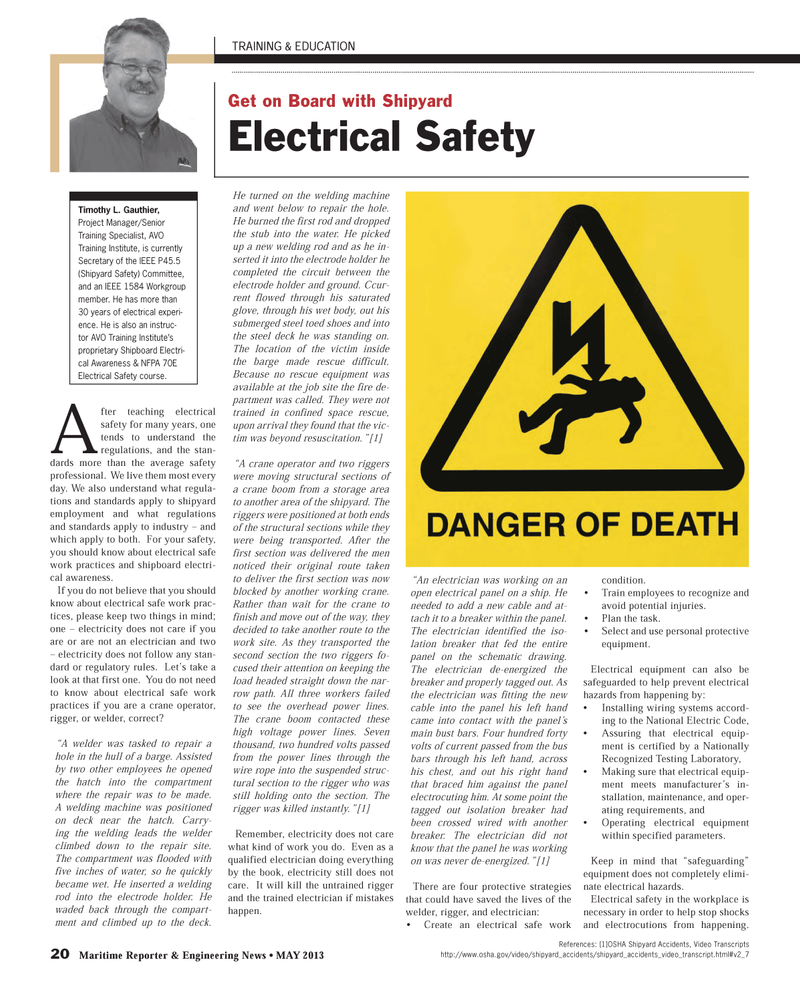
Page 20: of Maritime Reporter Magazine (May 2013)
Energy Production & Transportation
Read this page in Pdf, Flash or Html5 edition of May 2013 Maritime Reporter Magazine
20 Maritime Reporter & Engineering News ? MAY 2013 After teaching electrical safety for many years, one tends to understand the regulations, and the stan-dards more than the average safety professional. We live them most every day. We also understand what regula- tions and standards apply to shipyard employment and what regulations and standards apply to industry ? and which apply to both. For your safety, you should know about electrical safe work practices and shipboard electri-cal awareness.If you do not believe that you should know about electrical safe work prac-tices, please keep two things in mind; one ? electricity does not care if you are or are not an electrician and two ? electricity does not follow any stan-dard or regulatory rules. Let?s take a look at that first one. You do not need to know about electrical safe work practices if you are a crane operator, rigger, or welder, correct? ?A welder was tasked to repair a hole in the hull of a barge. Assisted by two other employees he opened the hatch into the compartment where the repair was to be made. A welding machine was positioned on deck near the hatch. Carry-ing the welding leads the welder climbed down to the repair site. The compartment was flooded with five inches of water, so he quickly became wet. He inserted a welding rod into the electrode holder. He waded back through the compart- ment and climbed up to the deck. He turned on the welding machine and went below to repair the hole. He burned the first rod and dropped the stub into the water. He picked up a new welding rod and as he in- serted it into the electrode holder he completed the circuit between the electrode holder and ground. Ccur- rent flowed through his saturated glove, through his wet body, out his submerged steel toed shoes and into the steel deck he was standing on. The location of the victim inside the barge made rescue difficult. Because no rescue equipment was available at the job site the fire de- partment was called. They were not trained in confined space rescue, upon arrival they found that the vic-tim was beyond resuscitation.?[1] ?A crane operator and two riggers were moving structural sections of a crane boom from a storage area to another area of the shipyard. The riggers were positioned at both ends of the structural sections while they were being transported. After the first section was delivered the men noticed their original route taken to deliver the first section was now blocked by another working crane. Rather than wait for the crane to finish and move out of the way, they decided to take another route to the work site. As they transported the second section the two riggers fo-cused their attention on keeping the load headed straight down the nar- row path. All three workers failed to see the overhead power lines. The crane boom contacted these high voltage power lines. Seven thousand, two hundred volts passed from the power lines through the wire rope into the suspended struc- tural section to the rigger who was still holding onto the section. The rigger was killed instantly.?[1] Remember, electricity does not care what kind of work you do. Even as a qualified electrician doing everything by the book, electricity still does not care. It will kill the untrained rigger and the trained electrician if mistakes happen.?An electrician was working on an open electrical panel on a ship. He needed to add a new cable and at-tach it to a breaker within the panel. The electrician identified the iso-lation breaker that fed the entire panel on the schematic drawing. The electrician de-energized the breaker and properly tagged out. As the electrician was fitting the new cable into the panel his left hand came into contact with the panel?s main bust bars. Four hundred forty volts of current passed from the bus bars through his left hand, across his chest, and out his right hand that braced him against the panel electrocuting him. At some point the tagged out isolation breaker had been crossed wired with another breaker. The electrician did not know that the panel he was working on was never de-energized.?[1] There are four protective strategies that could have saved the lives of the welder, rigger, and electrician: ? Create an electrical safe work condition.? Train employees to recognize and avoid potential injuries.? Plan the task. ? Select and use personal protective equipment.Electrical equipment can also be safeguarded to help prevent electrical hazards from happening by:? Installing wiring systems accord- ing to the National Electric Code,? Assuring that electrical equip- ment is certified by a Nationally Recognized Testing Laboratory, ? Making sure that electrical equip- ment meets manufacturer?s in- stallation, maintenance, and oper- ating requirements, and? Operating electrical equipment within specified parameters.Keep in mind that ?safeguarding? equipment does not completely elimi-nate electrical hazards. Electrical safety in the workplace is necessary in order to help stop shocks and electrocutions from happening. TRAINING & EDUCATION Get on Board with Shipyard Electrical SafetyTimothy L. Gauthier, Project Manager/Senior Training Specialist, AVO Training Institute, is currently Secretary of the IEEE P45.5 (Shipyard Safety) Committee, and an IEEE 1584 Workgroup member. He has more than 30 years of electrical experi-ence. He is also an instruc-tor AVO Training Institute?s proprietary Shipboard Electri- cal Awareness & NFPA 70E Electrical Safety course.References: [1]OSHA Shipyard Accidents, Video Transcripts http://www.osha.gov/video/shipyard_accidents/shipyard_accidents_video_transcript.html#v2_7 MR #5 (18-25).indd 20MR #5 (18-25).indd 204/30/2013 9:37:28 AM4/30/2013 9:37:28 AM

 19
19

 21
21
